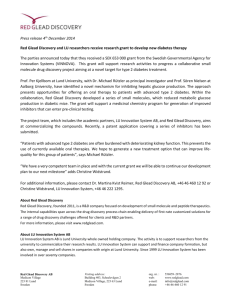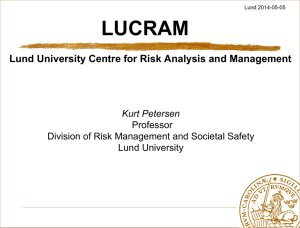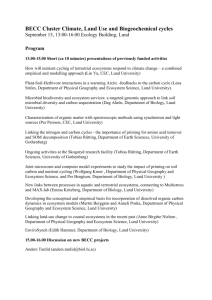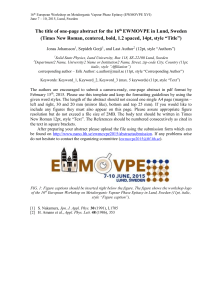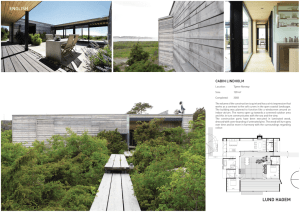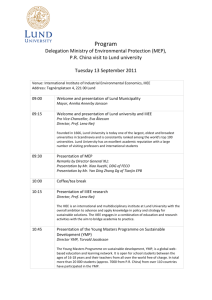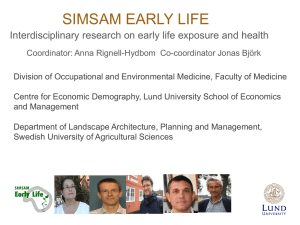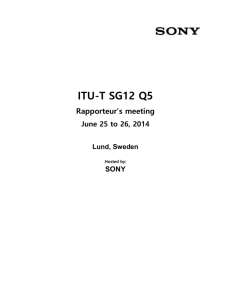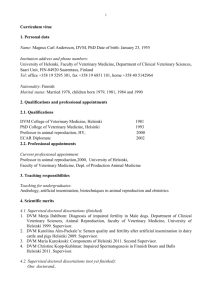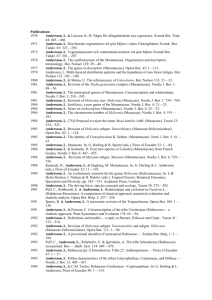Program - BI Norwegian Business School
advertisement
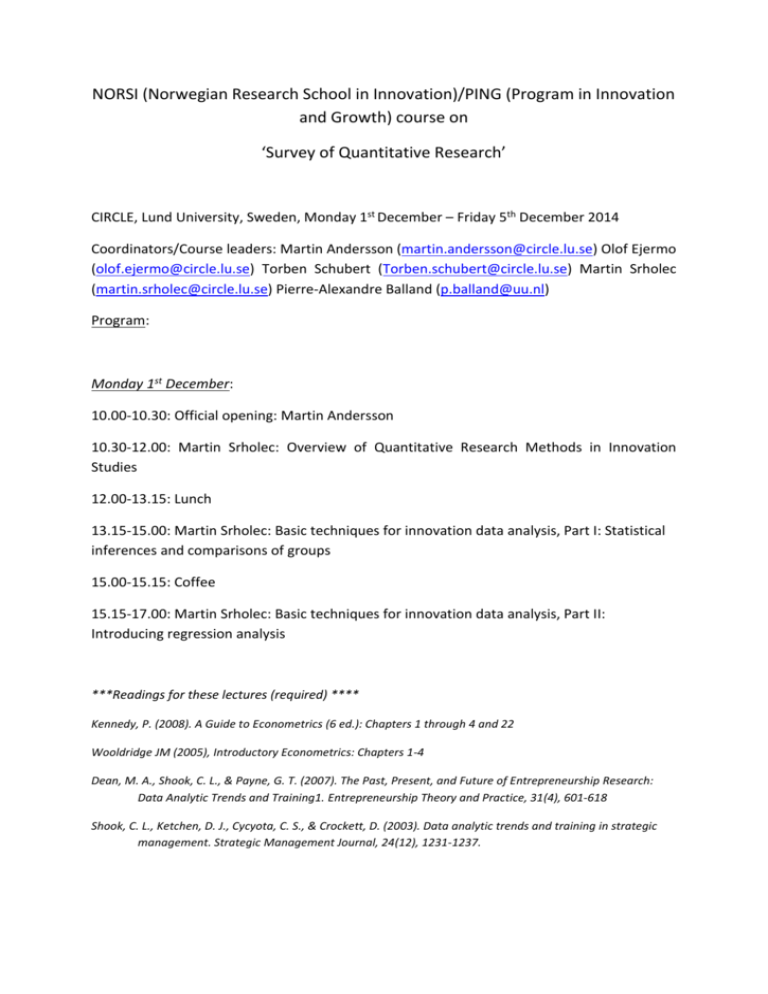
NORSI (Norwegian Research School in Innovation)/PING (Program in Innovation and Growth) course on ‘Survey of Quantitative Research’ CIRCLE, Lund University, Sweden, Monday 1st December – Friday 5th December 2014 Coordinators/Course leaders: Martin Andersson (martin.andersson@circle.lu.se) Olof Ejermo (olof.ejermo@circle.lu.se) Torben Schubert (Torben.schubert@circle.lu.se) Martin Srholec (martin.srholec@circle.lu.se) Pierre-Alexandre Balland (p.balland@uu.nl) Program: Monday 1st December: 10.00-10.30: Official opening: Martin Andersson 10.30-12.00: Martin Srholec: Overview of Quantitative Research Methods in Innovation Studies 12.00-13.15: Lunch 13.15-15.00: Martin Srholec: Basic techniques for innovation data analysis, Part I: Statistical inferences and comparisons of groups 15.00-15.15: Coffee 15.15-17.00: Martin Srholec: Basic techniques for innovation data analysis, Part II: Introducing regression analysis ***Readings for these lectures (required) **** Kennedy, P. (2008). A Guide to Econometrics (6 ed.): Chapters 1 through 4 and 22 Wooldridge JM (2005), Introductory Econometrics: Chapters 1-4 Dean, M. A., Shook, C. L., & Payne, G. T. (2007). The Past, Present, and Future of Entrepreneurship Research: Data Analytic Trends and Training1. Entrepreneurship Theory and Practice, 31(4), 601-618 Shook, C. L., Ketchen, D. J., Cycyota, C. S., & Crockett, D. (2003). Data analytic trends and training in strategic management. Strategic Management Journal, 24(12), 1231-1237. Tuesday 2nd December: 10.15-12.00: Olof Ejermo: Methods and applications using innovation count data part I 12.00-13.15: Lunch 13.15-15.00: Olof Ejermo: Methods and applications using innovation count data part II 15.00-15.15: Coffee 15.15-17.00: Olof Ejermo: Lab session ***Readings for these lectures (required) **** SMITH, K. 2005. Measuring innovation. In: FAGERBERG, J., MOWERY, D. C. & NELSON, R. R. (eds.) The Oxford Handbook of Innovation. New York: Oxford University Press VAN DER PANNE, G. 2007. Issues in measuring innovation. Scientometrics, 71, 495-507. JAFFE, A. B., TRAJTENBERG, M. & HENDERSON, R. 1993. Geographic Localization of Knowledge Spillovers as Evidenced by Patent Citations. Quarterly Journal of Economics, 108, 577-598 Wednesday 3rd December: 10.00-12.00: Pierre-Alexandre Balland: Social network analysis in innovation studies 12.00-13.00: Lunch 13.00-15.00: Pierre-Alexandre Balland: Lab Session I 15.00-15.15: Coffee 15.15-17.15: Pierre-Alexandre Balland: Lab session II ***Readings for these lectures (required) **** Giuliani, E., & Bell, M. (2005). The micro-determinants of meso-level learning and innovation: evidence from a Chilean wine cluster. Research policy, 34(1), 47-68. Ter Wal, A. L., & Boschma, R. A. (2009). Applying social network analysis in economic geography: framing some key analytic issues. The Annals of Regional Science, 43(3), 739-756. Balland, P. A., De Vaan, M., & Boschma, R. (2013). The dynamics of interfirm networks along the industry life cycle: The case of the global video game industry, 1987–2007. Journal of Economic Geography, 13(5), 741-765. Thursday 4th December: 10.15-12.00: Martin Andersson: Longitudinal data analysis - methods and applications in innovation studies part I 12.00-13.15: lunch 13.15-14.45: Martin Andersson: Longitudinal data analysis - methods and applications in innovation studies part II 14.45-15.00: Coffee 15.00-16.00: Lab session ***Readings for these lectures (required) **** Manski, C (2003), Identification Problems in the Social Sciences and Everyday Life, Southern Economic Journal¸70 (1), pages 11-21 Lecture notes on Identification Strategies by Stepan Jurajda: http://home.cerge-ei.cz/jurajda/rms07b.pdf Kennedy, P. (2008). A Guide to Econometrics (6 ed.): Chapter 18 Friday 5th December: 09.15-12.00: Torben Schubert: Survey design, including cluster and factor analysis 12.00-13.15: Lunch 13.15-15.00: Torben Schubert: Hypothesis testing using Community Innovation Survey data 15.00-15.15: Coffee 15.15-17.00: Torben Schubert: Lab session ***Readings for these lectures (required) **** Wooldridge JM (2005), Introductory Econometrics: Chapter 17 Application date: XXXXXXXXXXXXXXXXXXXX Evaluation To obtain 5 ECTS point requires active participation during the course as well as an accepted paper of 3.000-4.000 words demonstrating competence in using quantitative methods. The paper should be based on the topic of the PhD thesis and reflect literature used in the course. If quantitative methods will not be used in the thesis a paper answering given tasks could substitute a normal paper. However, the concrete form of the written delivery can be further discussed during the course. Practical information How to get to Lund: The closest international airport to Lund is Copenhagen Airport (also known as "Kastrup"), in Denmark. The train connection from Copenhagen Airport to Lund is fast (35 minutes) and frequent (every 20 minutes). Train tickets can be purchased from the “Skånetrafiken” ticket machines in the arrivals hall, near the escalators going down to the train platform. You can pay in Euros, Swedish kronor or Danish kronor, and you can use a debit/credit card with a chip. The journey will take you over the Öresund Bridge connecting Denmark to Sweden and via Malmö central station to Lund central station. The closest local airport to Lund is Malmö Airport (also known as “Sturup”). It has flights from other Swedish airports including Stockholm and some international flights from destinations within Europe. There is an airport shuttle bus to Malmö airport (called “Flygbussarna”) or you can get a taxi to Lund. Accommodation: Please choose the accommodation that suits you best. We can recommend “StayAt Lund” with reasonable prices and the more expensive “Hotel Concordia”, both located in the city centre. You can find, compare and book hotels at Lund’s tourist office: http://www.lund.se/en/Tourist-Information/Accomodation/ How to get to CIRCLE: The workshop will take place at CIRCLE, located within 15 walking minutes from the train station and the city centre. Street address is Sölvegatan 16, Lund. Find the location on Google maps: http://tinyurl.com/a68tt3o
